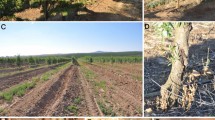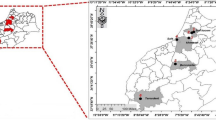Abstract
Indonesia is one of the world’s leading producers of vanilla, an important cash crop for smallholders. Stem rot disease is a major constraint to vanilla production in Indonesia and has caused significant economic losses over the last decade. Previous reports of vanilla stem rots in the Asia-Pacific region include those caused by Fusarium, Colletotrichum and Phytophthora species. In this paper, we report Fusarium species associated with the disease. Seven major vanilla-producing provinces were surveyed for disease incidence and 850 samples were collected. Isolates were recovered from diseased stem tissues using a selective medium. Pure cultures on carnation leaf-piece agar and potato dextrose agar were identified based on morphological criteria. Some ambiguous species were verified based on DNA sequences of the translation elongation factor gene.Atotal of 542 Fusarium isolates were recovered, comprising 12 species, namely F. decemcellulare, F. fujikuroi, F. graminearum, F. mangiferae, F. napiforme, F. oxysporum, F. polyphialidicum, F. proliferatum, F. pseudocircinatum, F. semitectum, F. solani and F. subglutinans. F. oxysporum was the most commonly isolated species from all areas surveyed, followed by F. solani and F. semitectum. F. oxysporum, F. solani and F. semitectum were tested for pathogenicity to vanilla but only F. oxysporum was shown to be pathogenic. The vanilla stem rot pathogen in Indonesia is verified to be F. oxysporum f. sp. vanillae.
Similar content being viewed by others
References
Alabouvette C, Schippers B, Lemanceau P, Baker PAHM (1998) Biological control of Fusarium wilts. In ‘Plant-microbe interactions and biological control’. (Eds GJ Boland, LD Kuykendall) pp. 15–36. (Marcel Dekker: New York)
Alconero R, Santiago AG (1969) Fusaria pathogenic to Vanilla. Plant Disease Reporter 53, 854–857.
Athman SY, Dubois T, Coyne D, Gold CS, Labuschagne N, Viljoen A (2007) Effect of endophytic Fusarium oxysporum on root penetration and reproduction of Radopholus similis in tissue culture-derived banana (Musa spp.) plants. Nematology 9, 599–607. doi: 10.1163/ 156854107782024839
Belabid L, Baum M, Fortas Z, Bouznad Z, Eujayl I (2004) Pathogenic and genetic characterization of Algerian isolates of Fusarium oxysporum f. sp. lentis by RAPD and AFLP analysis. African Journal of Biotechnology 3, 25–31.
Burgess LW (1981) General ecology of the fusaria. In ‘Fusarium: diseases, biology, and taxonomy’. (Eds PE Nelson, TA Toussoun, RJ Cook) pp. 225–235. (Pennsylvania State University Press: University Park, PA)
Burgess LW, Summerell BA, Bullock S, Gott KP, Backhouse D (1994) ‘Laboratory manual for Fusarium research.’ 3rd edn. (University of Sydney: Sydney)
Conover WJ (1999) Cochran’s test for related observations. In ‘Practical nonparametric statistics’. pp. 250–258. (John Wiley and Sons Inc.: New York)
Dignum MJW, Kerler J, Verpoorte R (2001) Vanilla production: technological, chemical, and biosynthesis aspects. Food Reviews International 17, 199–219.
DiPietro A, Madrid MP, Caracuel Z, Delgado-Jarana J, Roncero MIG (2003) Fusarium oxysporum: exploring the molecular arsenal of a vascular wilt fungus. Molecular Plant Pathology 4, 315–325. doi: 10.1046/j.1364-3703.2003.00180.x
El Hadrami A, El Idrissi-Tourane A, El Hassni M, Daayf F, El Hadrami I (2005) Toxin-based in-vitro selection and its potential application to date palm for resistance to the bayoud Fusarium wilt. Comptes Rendus Biologies 328, 732–744. doi: 10.1016/j.crvi.2005.05.007
Elizabeth KG (2002) Vanilla: an orchid spice. Indian Journal of Arecanut Spices and Medicinal Plants 4, 96–98.
Farreyrol K, Pearson MN, Grisoni M, Leclercq-Le Quillec F (2001) Severe stunting of Vanilla tahitensis in French Polynesia caused by Cucumber mosaic virus (CMV), and the detection of the virus in V. fragrans in Reunion Island. Plant Pathology 50, 414. doi: 10.1046/j.1365-3059.2001.00579.x
Fouché JG, Jouve L (1999) Vanilla planifolia: history, botany and culture in Reunion Island. Agronomie 19, 689–703. doi: 10.1051/agro:19990804
Fravel D, Olivain C, Alabouvette C (2003) Fusarium oxysporum and its biocontrol. The New Phytologist 157, 493–502. doi: 10.1046/j.1469-8137.2003.00700.x
Kuldau GA, Yates IE (2000) Evidence for Fusarium endophytes in cultivated and wild plants. In ‘Microbial endophytes’. (Eds CW Bacon, JF White) pp. 85–117. (Marcel Dekker: New York)
Larkin RP, Fravel DR (1998) Efficacy of various fungal and bacterial biocontrol organisms for control of Fusarium wilt of tomato. Plant Disease 82, 1022–1028. doi: 10.1094/PDIS.1998.82.9.1022
Larkin RP, Fravel DR (2002) Effects of varying environmental conditions on biological control of Fusarium wilt of tomato by nonpathogenic Fusarium spp. Phytopathology 92, 1160–1166. doi: 10.1094/PHYTO. 2002.92. 11.1160
Larkin RP, Hopkins DL, Martin FN (1996) Suppression of Fusarium wilt of watermelon by non-pathogenic Fusarium oxysporum and other microorganisms recovered from a disease-suppressive soil. Phytopathology 86, 812–819. doi: 10.1094/Phyto-86-812
Leslie JF, Summerell BA (2006) ‘Fusarium laboratory manual.’ (Blackwell Publishing: Ames, IA)
Leslie JF, Pearson CAS, Nelson PE, Toussoun TA (1990) Fusarium species from corn, sorghum and soybean fields in the central and eastern United States. Phytopathology 80, 343–350. doi: 10.1094/Phyto-80-343
Lestari EG, Sukmadjaja D, Mariska I, Hobir, Tombe M, Kosmiatin M, Rusyadi Y, Rahayu S (2001) Perbanyakan in vitro dan pengujian lanjutan pada nomor-nomor harapan Panili dan Lada yang tahan penyakit. (Eds I Mariska, IH Somantri, MM Sutrisno, RDM Simanungkalit, OIN Suyono) pp. 109–118. (Balai Penelitian Bioteknologi Tanaman Pangan, Pusat Penelitian dan Pengembangan Tanaman Pangan, Bogor)
Liew ECY, Rondonuwu F, Pinaria A, Sembel DT, Summerell BA, Burgess LW (2004) Fusarium stem rot of vanilla in North Sulawesi. (Abstract). Phytopathology 94 (Suppl.), S61.
Louvet J, Toutain G (1981) Bayoud, Fusarium wilt disease. In ‘Fusarium: diseases, biology, and taxonomy’. (Eds PE Nelson, TA Toussoun, RJ Cook) pp. 13–20. (The Pennsylvania State University Press: University Park, PA)
Maciá-Vicente JG, Jansson HB, Abdullah SK, Descals E, Salinas J, Lopez-Liorca LV (2008) Fungal root endophytes from natural vegetation in Mediterranean environments with special reference to Fusarium spp. FEMS Microbiology Ecology 64, 90–105. doi: 10.1111/ j.1574-6941.2007.00443.x
Moore NY, Pegg KG, Buddenhagen IW, Bentley S (2001) Fusarium wilt of banana: a diverse clonal pathogen of a domesticated clonal host. In ‘Fusarium: Paul E. Nelson Memorial Symposium’. (Eds BA Summerell, JF Leslie, D Backhouse, WL Bryden, LW Burgess) pp. 212–224. (APS Press: St Paul, MN)
Muheim A, Lerch K (1999) Towards a high-yield bioconversion of ferulic acid to vanillin. Applied Microbiology and Biotechnology 51, 456–461. doi: 10.1007/s002530051416
O’Donnell K, Kistler HC, Cigelnik E, Ploetz RC (1998) Multiple evolutionary origins of the fungus causing panama disease of banana: concordant evidence from nuclear and mitochondrial gene genealogies. Proceedings of the National Academy of Sciences of the United States of America 95, 2044–2049. doi: 10.1073/pnas.95.5.2044
Pearson MN, Jackson GVH, Pone SP, Howitt RLJ (1993) Vanilla viruses in the South Pacific. Plant Pathology 42, 127–131. doi: 10.1111/j.1365-3059.1993.tb01479.x
Phan H (2006) Fusarium species associated with tropical grasses in Australia. PhD Thesis, The University of Sydney.
Ploetz RC (2001) Significant diseases in the tropics that are caused by species of Fusarium. In ‘Fusarium: Paul E. Nelson Memorial Symposium’. (Eds BA Summerell, JF Leslie, D Backhouse, WL Bryden, LW Burgess) pp. 295–309. (APS Press: St Paul, MN)
Roling WFM, Kerler J, Braster M, Apriyantono A, Stam H, Verseveld H (2001) Microorganisms with a taste for vanilla: microbial ecology of traditional Indonesian vanilla curing. Applied and Environmental Microbiology 67, 1995–2003. doi: 10.1128/AEM.67.5.1995-2003.2001
Summerell BA, Salleh B, Leslie JF (2003) A utilitarian approach to Fusarium identification. Plant Disease 87, 117–128. doi: 10.1094/ PDIS.2003.87.2.117
Theis T, Jimenez FA (1957) A Vanilla hybrid resistant to root rot. Phytopathology 47, 79–81.
Thomas J, Suseela B (2001) Sclerotium rot — a new disease of vanilla (Vanilla planifolia Andrews) in India. Journal of Spices and Aromatic Crops 9, 175–176.
Thomas J, Vijayan AK, Bhai RS (2002) Vanilla disease in India and their management. Indian Journal of Arecanut Spices and Medical Plants 4, 143–149.
Tombe M, Sitepu D (1986) The control of stem rot of Vanilla with fungicides. Edisi Khusus Penelitian Rempah dan Obat 2, 43–47.
Tombe M, Tsuchiya K, Nurawan A, Nazarudin SB, Oniki M, Matsumoto K (1992) Experiments on the introduction of biological and cultural control of stem rot disease of vanilla. Industrial Crop Research Journal 4, 20–26.
Tombe M, Komoto Y, Tezuka N (1993) Identification and cultural types of Fusarium isolates from Vanilla in Indonesia. Industrial Crop Research Journal 6, 1–5.
Tombe M, Sitepu D, Mogi S (1997) Present status of biological control research of vanilla stem rot disease in Indonesia. In ‘Proceedings of the 4th international workshop on plant growth promoting rhizobacteria, Sapporo, Japan’. (Eds A Ogoshi, K Kobayashi, Y Homma, F Kodama, N Kondo, S Akino) pp. 13–21. (OECD: Paris)
Vu T, Hauschild R, Sikora RA (2006) Fusarium oxysporum endophytes induced systemic resistance against Radopholus similis on banana. Nematology 8, 847–852. doi: 10.1163/156854106779799259
Walsh JL (2007) Fusarium species associated with savanna ecosystem in Australia: taxonomy, ecology and pathogenicity. PhD Thesis, The University of Sydney.
Wang B, Priest MJ, Davidson A, Brubaker CL, Woods MJ, Burdon JJ (2007) Fungal endophytes of native Gossypium species in Australia. Mycological Research 111, 347–354. doi: 10.1016/j.mycres.2006.11.004
Westcott RJ, Cheetham PSJ, Barraclough AJ (1993) Use of organised viable Vanilla plant aerial roots for the production of natural vanillin. Phytochemistry 35, 135–138. doi: 10.1016/S0031-9422(00)90521-1
Wisler GC, Zettler FW, Mu L (1987) Virus infection of Vanilla and other orchids in French Polynesia. Plant Disease 71, 1125–1129. doi: 10.1094/ PD-71-1125
Author information
Authors and Affiliations
Corresponding author
Rights and permissions
About this article
Cite this article
Pinaria, A.G., Liew, E.C.Y. & Burgess, L.W. Fusarium species associated with vanilla stem rot in Indonesia. Australasian Plant Pathol. 39, 176–183 (2010). https://doi.org/10.1071/AP09079
Received:
Accepted:
Issue Date:
DOI: https://doi.org/10.1071/AP09079




